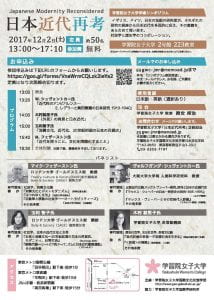The Symposium “Japanese Modernity Reconsidered”
Gakushuin Women’s College Symposium (Tokyo Japan), ‘Japanese Modernity Reconsidered’ on Sat 2nd December, 2017.
It can be said that sociology started as a reflexive understanding of modernity. For that reason, ‘What modernity or what a modernizing process is’ has always been an important issue for sociology. After a hundred years studies, sociologists seem to accept that there are several routs or courses of modernization. Japan is one of the earliest societies that began modernization processes outside of the West. Therefore, the modernization of Japanese society has been a controversial topic not only in Japan but in other countries. From the perspective of multiple modernities, what significance can be attached to the modernizing process of Japan? What kind of implications can the modifier “Japanese” carry?
With the general awareness of the globalizing world, it is getting more and more important to reconsider questions such as; What is ‘Japanese’ modernity? Is it unique? If so, what makes it unique? What changes have happened to Japanese society? Or what impact does Japan have on the globalizing, modernizing world?
Speakers
Mike Featherston (Professor at Goldsmiths, University of London)
Wolfgang Schwentker (Professor at Osaka University)
Tomoko Tamari (Lecturer at Goldsmiths, University of London)
Eriko Kimura (Lecturer at Gakushuin Women’s College)
Mike Featherstone: Questioning Modernity and Problematizing Culture
The Latin term modernus was first used in the fifth century AD/CE to distinguish between the Christian present and the pagan Roman past. It pointed to the beginning of a new era. The conceptualization of a new era or epoch tends to denigrate the past and create a dichotomy – modernity versus tradition. In more recent understandings of modernity it is the economy and technology, or as some would call it ‘the techno-economic subsystem,’ that is seen as the dynamic driving force. Yet what about the role of culture in modernity? For modernisers culture is defined as static, conservative and fixed. It is seen as tradition and backward – something lagging behind. Does this mean there cannot be a modern culture? A modern culture happy to co-exist with change and techno-economic advance? Culture as the quest for the new. This paper will first of all take a look at the family of terms deriving from the modern. Secondly, ask the question of how to locate modernity – whether it is not just in time, but also in space. Then the question is posed: ‘Is modernity Western?’ Thirdly, the paper briefly focuses on the problem of Japanese modernity and Japanese exceptionalism. Fourthly, it outlines the role of culture and experience in modernity. Fifthly, asks if it is possible to think beyond the modern under conditions of the limits of global consumption and the accumulation of planetary risks? Sixthly and finally, ask whether there are potential trans-modern forms of life, which throw into question modern values and the ‘endless pursuit of meaning.’
Tomoko Tamari: Consumer Culture, Modernization and the Department Store in Early 20th Century Japan
The paper focuses on the ways in which the department store has become a key site for the constitution of Japanese modernity though the introduction of ideas and goods from the West along with the emphasizes on aesthetic design and sophisticated taste. The department store not only provided new goods along with pragmatic ideas of how to use and how to evaluate them, but sought to promote images and advice on how to integrate the ‘new’ into existing lifestyles and value systems. As a new form of aestheticized consumer space along with its theatrical setting, the department store also provided performance spaces with ‘front and back stage’ areas where one can look and be looked at. For particularly women in the city, department stores in the burgeoning modern consumer culture, offered exciting experiences and opportunities. The theatrical nature of the store with its spectacular and luxurious setting encouraged the exploration of new female identities and escape from the routines of mundane everyday life. In this process, the department store provided a form of women’s public sphere where they could enjoy learning how to be modern. In addition, it should be emphasized that in the Japanese case, the department store also played an important role, not just as a new cultural institute to promote the new lifestyles, but also a key political device for the government who advocated ‘the reform of everyday life’. This involvement resulted in creating Japanese modern consumers. They had aesthetic sensibilities which were not just an ability to classify and value the new consumer goods, but also a capacity to appreciate ‘personal affection’ and ‘aesthetic enjoyment’ through new consumer experience. This can be understood as part of evidence of the process of aestheticization of everyday life. In this context, we can see that Mitsukoshi was a major cultural repository, a significant interpreter and promoter of aestheticization of everyday life, which was central to the development of Japanese consumer culture in Japan’s 20th century modernizing process.

Gakushuin Women’s College Symposium (Tokyo Japan), ‘Japanese Modernity Reconsidered’ on Sat 2nd December, 2017